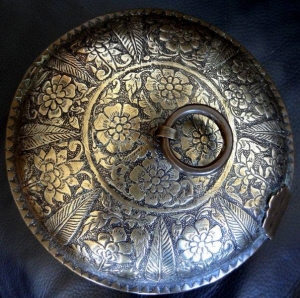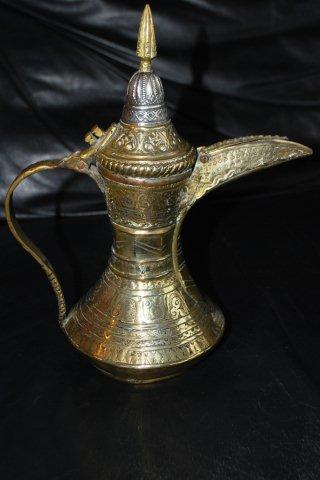 |
|
Omani antique brass pot
|
Below you find a collection of antique brass and copper utensils from Oman.In addition to the high quality silversmith work we also find very skilled coppersmiths in Oman.The town of Nizwa in the interior of Oman has often been associated with the production of coffee pots, so called Dallah. Colonel S.B. Miles in his "Across the green mountains of Oman in 1876" he describe: That copper manufacturing one of the principals industries of Nizwa was. Nearly all household utensils of the people living on the Jebel Akhdar were made of copper and only very little earthenware. Also that the copper items were purchased in Nizwa. Miles elsewhere writes: The copper-work from Nizwa is well known for its quality and was widely distributed through the country. The copper-market which though inviting by the quaintness of its wares , is repellent from the incessant noise and deafening din of the hammering going on"
Nizwa has been a centre of high quality copper-work. In the ancient workplaces of the old copper-souq (that no longer exists) you could find under loads of dust old Persian style copper work. The more modern style of copper-work (like in the water-bowl below) is probably a "water-downed version" of the old Persian styles. When trying to date this type of metalwork it is tempting to say "the more detailed and elegant the work is the more ancient the item is" However for a long time Persians and Persian goods were banned from Oman because of them occupying the country several times. Relations between Oman and Persia were normalized when Sultan Said married a (wild and promiscuous) Persian princess in the 1830´s

A formal meal of any sort will entail the use of several different sorts of vessel. Ceremonial articles such as coffee pots, trays, halwa spoons, water bowls, incense burners and rosewater sprinklers are normally very decorative often with floral designs. On the process of making coffee in Arabia: Zwemer in 1902 in his "Topsy Turvy land Arabia pictured for children" writes page 34/35: " The raw coffee-bean is roasted just before it is used and so keeps all its strength; it is pounded fine and lastly when it is boiled two smelling herbs (heyl and saffron) are added, just enough to give a flavour. Some fibres of palm bark are stuck into the spout of the coffee pot to act as a strainer and then the clear brown liquid is poured into a tiny cup and handed out"

is a photo of an Omani Dallah made of tinned copper

Fig 75 in the book "Handwerk und industrie in Ost Afrika Hamburg 1910" by Franz Stuhlmann
is a photo of a silver container with medallions containing abstract floral designs. The container shown was according to Stuhlmann made made in Zanzibar or Pangani
The use of medallions with abstract floral or animal designs in metal work may suggest that the design is originally derived from Persian metalwork. In Oman we used to find very fine antique brass containers and rosewater sprinklers with similar medallions containing floral designs but also funny cartoon like animals. Typically gazelles and leopards and occasionally peacocks or elephants) However we also find brass containers with just floral designs in the medallions.


The book "Doors of Zanzibar" 1998 with photos by Uwe Rau and text by Mwalim A. Mwalim contains photos of 94 antique Arab doors in and around Zanzibar stone town. Representation of animate objects is forbidden in Islam.The design of a couple of the carved Arab doors did contain birds (e.g. peacock) and lions similar to those found on Omani brass vessels. Even on one of the carved doors of the Sultan's House of Wonders contained a carved bird and lions. On several other antique doors in Zanzibar Stonetown (e.g. house Tippu Tip) the carved animals have been removed, thereby reflecting differences over time on how strict to interpret these Islamic rules. The majority of doors did not contain animal decoration. In recent years we saw quite a few Omani girls decorating their scarf's with silver brooches, it is probably human to explore the limits of what is allowed!

In 1672 a Dutch ship came to Muscat and a Dutchmen named Padtbrugge visited the Muscat souq. He writes that trade and crafts are mostly practised by people from Sind and Banians (Hindus). However there are many Arabian rifle-makers and sword-cutlers, anchor blacksmiths and canon-ball blacksmiths as they do not know how to melt and cast Iron etc. “The coating with tin by use of sal-ammoniac is here as usual as in Persia, because all their pots, saucers, and table dishes are made of brass” Hence it is possible that copper-work in the Import section was made in Oman and date quite early.